Soy Luster is a relatively new needlework thread on the market, and just as its name implies, it’s made from soy, of all things. Well, why not? Linen is made from an edible crop – flax – and cotton is grown like vegetables, too, though I doubt there’s an edible by-product! I’ve been playing around with the Soy Luster threads, and you know what? I like them!
Soy Luster is Colorful Thread!
Soy Luster is a thread produced by The Pure Palette, and it comes in some pretty incredible – beautiful – colors. The line comes in solids and “shadows,” which are a kind of variegated thread. Well, it’s not variegated like some other threads – it’s actually three shades of the same color in one thread, combined in such a way that you can cut the threads and stitch with three separate shades, or you can stitch with a cut that has all three shades on it for a kind of heathered effect.
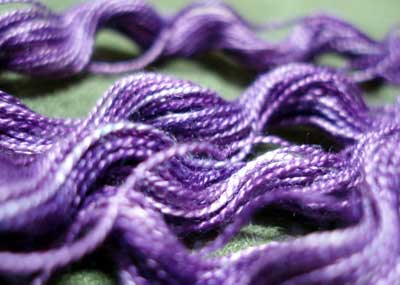
To view the color palette for the Soy Luster threads, you can visit the Pure Palette website, where you can scroll over each thread name and see a big ball of each color, or you can visit Needle in a Haystack, where they have all the colors of Soy Luster on one wonderful page.
It Really Is Thread Made from Soy!
The thread is indeed made from 100% soy. The thread itself is not made in America, but the dying is done here. The Shadows threads (variegated) are dyed to match the solids, which is a nice way to get a range of shades of the same color for different effects in your needlework.
On the Soy Luster website, you’ll find a description of the thread:
Soy Luster™ loves to be stitched. It responds to your hands, becoming softer and more luxuriant with each stitch. With no tangling, twisting, snagging or fraying, it is the ultimate fiber.
Earth friendly? Yes. 100% Soy Silk® and Formaldehyde Free. We all want to do something green for this earth. Now we can, in 82 delicious colors.
Personally, I’m always eager to try threads for myself to see if they are really all that the manufacturers claim them to be. When I first read the description, I kind of thought it might be a bit much – and, after all, soy “silk” seemed a bit of an oxymoron to me.
Well, I tried the thread. And here’s what I found…
They are pretty – I like the colors that I’ve tried so far. The Shadows threads are really very nice, and I like the fact that they have that heathery look to it.
The thread does have a nice subtle sheen to it, but it isn’t like silk in that regard. In fact, the thread is a bit fuzzy – more so, even, than cotton, though not as much as wool. Overall, Soy Luster has a “wooly” feel to it, though not as fluffy, and, unlike wool, it has a bit of a sheen to it.
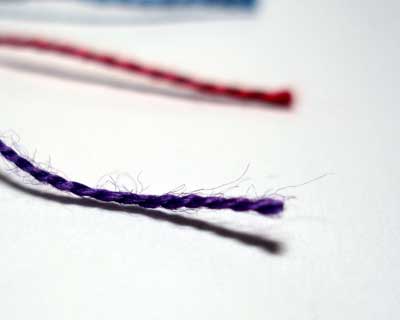
You can see the fuzzies protuding from the dark purple thread in the photo above. Keep in mind that this photo is Really Up Close. From far away, the thread doesn’t look fuzzy, but these little fibers contribute to the “wool” feel.
Size-wise, Soy Luster measures up to somewhere between a #8 perle cotton and a #12 perle cotton. The #8 perle is slightly thicker thread, I think, but the #12 may be just a tad finer – but it’s very close to the #12.
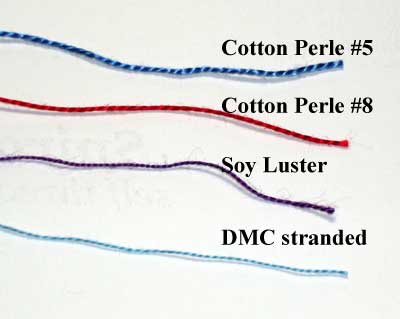
Unfortunately, I didn’t have a #12 perle cotton on hand, so what you see above, to give you a sense of the thickness of the thread, is a size comparison between common threads, from the #5 perle cotton on top (thickest) to one strand of DMC stranded cotton on the bottom (finest).
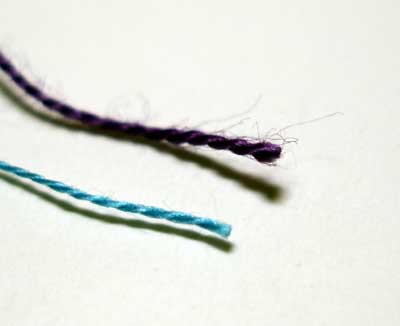
Above, you can see the Soy Luster (top dark purple) lined up right next to a single strand of DMC. LIke the DMC cotton, Soy Luster is two-ply twisted thread, but the plies are a bit “rounder” compared to the longer plies of the DMC stranded cotton.
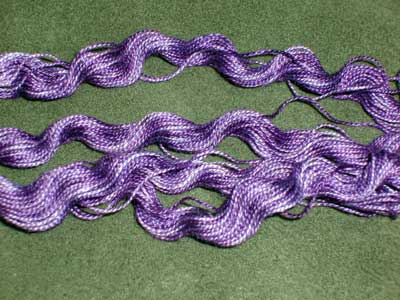
This is what the thread looks like when you cut open the twist (it comes in small tight twists). The thread seemed really boingy when I first cut the twist, and I couldn’t help thinking it was going to be a real pain to stitch with. But then I pulled out a single thread to try, gave the thread a tug from both ends, and it straightened right out.
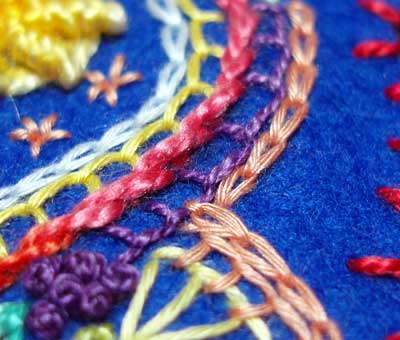
I wondered about that description on the manufacturer’s website: “…becoming softer and more luxurious…” “no tangling, no twisting” – it seems like a lot to promise in a thread. So I set about stitching with it, trying it with French knots – always difficult to stitch when using a temperamental thread – and buttonhole stitch, which tends to get twisty while working it.
Guess what? It really is a nice thread to stitch with! It was easy and smooth, no tangles, and it looks very pretty when stitched.
Finally, I also did a very basic color-fast test on it. Now, the smart thing to do when testing for color-fastness is to take a good clump of the thread and soak it, then leave it to dry on some white fabric. It’s also nice to know what the thread is like for stitching after being wet and dry – especially if you decide you want to treat it for colorfastness with salt or vinegar. But, anyway, I didn’t do that. I used a single strand and soaked it for a while in warm-ish water, on a little piece of white cloth.
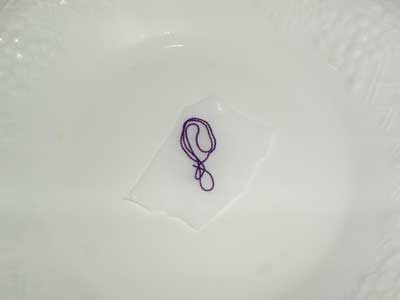
I took it out and let it dry on another piece of white cloth, and there was no color residue either in the water on the damp cloth or on the dry cloth. Red is usually the best color to test when you want to know if a thread is colorfast, because reds are often prone to bleeding, even in threads described as colorfast. Since I didn’t have red, though, I used the purple – and I was still pleased that there wasn’t a hint of purple color left behind.
Soy Luster in Summary
1. The color schemes are great – lovely solid colors, with matching variegated colors.
2. Though on first impressions, it seems as if it will be “springy” and difficult to stitch with, it is really nice to stitch with. The thread straightens up with a good tug.
3. The look of the thread is interesting – kind of like wool, with the sheen of cotton. I like that. I’m eager to try it on crewel-type projects. I think it would be very pretty. I can’t help wondering how it will take to long and short stitch, so I may have to try that and let you know!
Buying Soy Luster
You can find Soy Luster at Needle in a Haystack, where it runs $3.95 for a 36 yard skein. You can also find it at The Stitching Post, where it’s only $3.60 a skein. The price range is basically $3.60 – $3.95, depending on where you bu
y it.



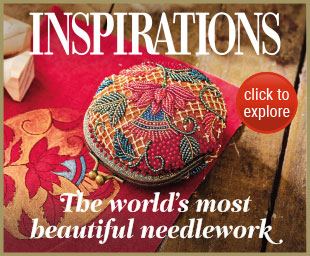

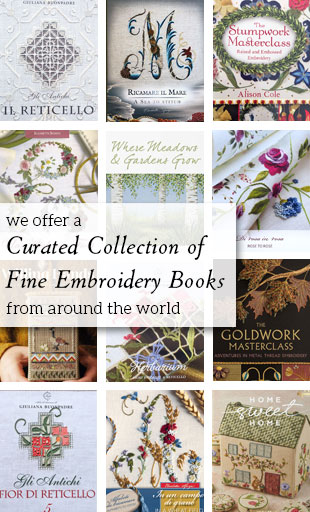

Your information is so helpful; thank you! I find soy fiber comfortable to wear; I have a pair of socks commercially knit from soy and they’re just great.
I found out in a New Age Fibers class, that most of the soybean “silk” is 45% soybean protein, 55% “other” – including resins and binders to keep the fiber together. I think that pure soy protein is probably too brittle. It can be listed as 100% soy fiber, in the same way that something can be 100% ketchup… it’s made of component ingredients that don’t have to be listed.
I forgot to put in this link:
http://www.swicofil.com/soybeanproteinfiberproperties.html
probably more information than you want, but it’s interesting!
Thanks a lot for this post. I’m going to try Soy Luster. By the way, The Stitching Post is about five miles from me, but since I don’t go out, I order online. It’s a nice, big store, though.